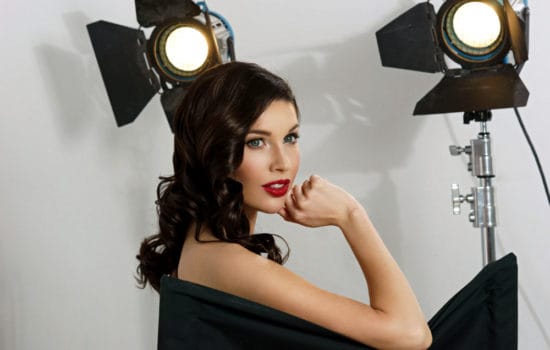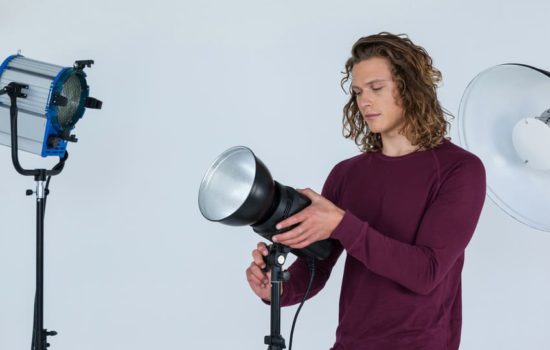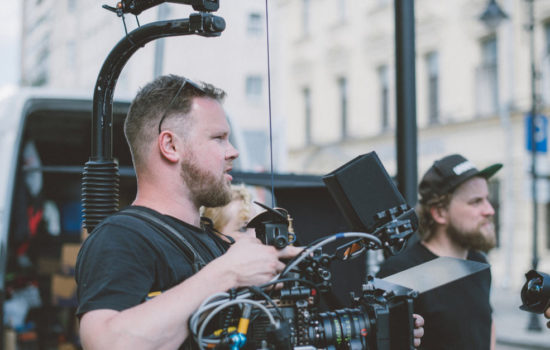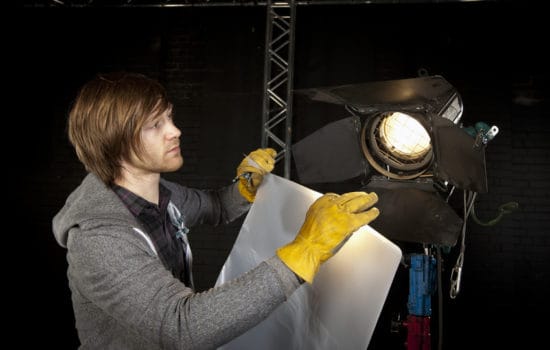You only get one shot at a first impression.
And first impressions in the Entertainment Industry can be everything. A script’s format is the first thing that jumps off the page when you’ve handed someone your material. The work is judged by that initial look. Making sure you’ve gotten it right, and adhering to the rules and guidelines of standard screenplay format is crucial to ensuring your material will be considered seriously. Let’s discuss the specific format required of a screenplay.
Sluglines set the scene via a few components. The first is denoting if the scene is taking place inside or outside (INT. for interiors, EXT. for exteriors). The next piece of information a slugline offers is the scene’s location. Finally, sluglines designate the time of day the scene is taking place (this is done using a dash after the location). Sluglines are always capitalized (they can be bolded as well, but that’s not necessarily required).
A sample slugline looks like this:
Sometimes, if there’s a specific location you want your reader to know the scene is taking place in, the slugline can be detailed with an addition to the location, like so –
Always remember to keep your sluglines brief. Save your descriptions for the action lines.
Action lines define what happens in your scenes. They describe the look of the scene and designate the characters’ movements inside it. In short, action lines lay out everything an audience can see onscreen. They’re also always written in present tense.
Occasionally, certain words or phrases can be bolded, underlined, capitalized or italicized for emphasis.
For instance:
…no time to stop, the car smashes right through the wall of the building. People scatter in the chaos…
While these highlights can be striking and fun to use, make sure not to overdo them. The effect of the underscoring tends to be less impactful with each use.
A character’s name should be capitalized the first time they appear onscreen. It also helps to give a bit of information about them – gender, age, and any personality specific(s) that would help define them in the reader’s mind (this benefits both story and casting purposes). Be descriptive, but brief. Don’t let a description slow down the pace of your narrative.
All spoken dialogue, whether in voiceover or in-scene should be written as dialogue. The name of the character speaking should appear in caps, centered on the page. The dialogue is also centered, and appears directly beneath their name.
If two characters are speaking at the same time, set the character names and dialogues side by side with one another. This is called dual dialogue.1
If you’re looking to make certain aspects of your characters’ dialogue be clearly distinct or very specific, you can put a parenthetical between the character’s name and their dialogue to provide some extra direction and context on how the line is meant to be performed. A parenthetical can add depth and meaning to dialogue. It’s also used to indicate a pause in speech, if the moment calls for it. Setting a pause, or a beat of silence, in a character’s speech is often used to offer a dramatic moment to land or allow the character to switch topics without confusing the reader or audience.
Here’s an example:
JOHN
I got the groceries.
(then)
What was it you were going to ask me?
Be careful about overusing parentheticals in scripts, as they can sometimes encroach on actors and/or directors (more on this in the “what not to include” section).
An Extension is an indicator placed to the right of a character’s name to explain how their voice will be heard. If a character is speaking in voiceover, denote this with a “V.O.” inside a parenthetical next to the character’s name. When a character is present in a scene but not visible on camera (either out of frame or in another room/adjacent location), place an “O.S.” for off-screen (“O.C.”, for off-camera, is also typically used) next to the character’s name above the dialogue.
Script transitions are cues to the reader on how changes to the next scene can be executed. They can be effective communicators on the mood of a scene when it comes to an end. Transitions are always capitalized and followed by a colon. Except for the final FADE OUT or CUT TO BLACK, which should be followed by a period.
The most common transitions are CUT TO, DISSLOVE TO, FADE IN and FADE OUT.
A shot is an action line describing what the camera is seeing in your script. For story purposes, it can sometimes be necessary to draw specific attention to certain details. But it’s important to remember that you’re writing your script, not directing it, so curtail any need you may have to design a camera movement. Your job as the writer is to describe, as clearly as possible, what it is the camera is seeing. How this is done is not the writer’s job, it’s the director’s.
So let’s dive into these, one at a time…
An original script is created entirely by the writer, without using any IP (Intellectual Property). It’s something that comes one hundred percent from a writer’s imagination and they are the sole owner of said work.
Adapted scripts are taken from other mediums (and sometimes even the same medium) to build a script. Often elements such as setting and character are translated according to their new medium so there’s a more flow and organic fit to the material.
A screenplay is a script written for the movies (a teleplay is a script written for television). It’s primarily focused on what the audience sees and hears. Unlike a novel, characters’ thoughts and feelings need to be externalized and clearly defined in screenplays. The only inner monologue one would find in a screenplay (or teleplay) is one heard in voice-over.
A storyboard is a script told using primarily images and minimal writing to tell the story. Storyboards can be very useful in terms of conveying a scene’s intent in a quick glance. For a fun video on how MAD MAX: FURY ROAD used storyboards instead of a script to tell its tale, watch this.
A spec, or “speculative” script is one executed by a writer to demonstrate their abilities without being commissioned by any company or studio to do so. More often than not, spec scripts aren’t written to sell as much as they’re used as calling cards in the hopes of garnering other work on projects with similar themes and tones.
Standalone scripts are specifically written for existing franchises and are typically used during production in the event of unexpected occurrences and an alternate script is needed to replace what was originally to be shot.
Less a screenplay and more of a guideline, a pitch script is a written treatment of sorts, breaking down all the key elements of a to-be-written script. It contains the major characters, plot points, setting, genre, tone, and all other necessary elements to convey the essence of the script you plan on writing. In brief, pitch scripts are written to get the writing job.
The shooting script is exactly that – the script that’s going to be shot in production. In addition to all of the format elements mentioned in this article, it also contains scene numbers, which aid the production team in better understanding what scenes are being shot and what is required for each one.
Does grammar matter in a screenplay?
Ari Eisner (CareersInFilm)
While screenwriting doesn’t require you adhere to every grammatical known tenet, following as closely as possible to grammar’s basic ground rules are essential for creating a smoother script which keeps your reader’s focus on the story you’re telling.
Equally important to what should be included in a script are some elements to leave out. Yes, these guidelines are strict, but they’re also necessary in order to get the format exactly right.
What should not be included in a script?
Ari Eisner (CareersInFilm)
Here’s a quick checklist of things to avoid in a screenplay…
- Loglines
- Anything the audience isn’t seeing
- Wordy scene setting (and wordiness in general)
- An excessive amount of parentheticals
- Camera direction
- Too many transitions
- Scene numbers
- Credits roll
Let’s take a deeper dive into what to leave out of a script…
It can be tempting to put a logline, a quick descriptive sentence of your story, on the title page (or immediately following, before the actual script begins). This isn’t part of a script’s standard format and should be avoided.
In novels, authors can put their readers inside characters’ heads and give them detailed insight into their thoughts and inner feelings. This doesn’t apply to scripts, where all the screenwriter should put in is what the audience is observing. Instead, try using dialogue and behavior/action to express your characters’ thoughts and emotions.
Scripts are meant to be fast reads. Stay away from over-description and try to economically express an idea in the fewest words possible. Your readers will thank you for it.
There’s a fine line between clarifying the way a line should be performed and stepping on an actor’s (and/or director’s) toes in telling them how to do their job. Sometimes a parenthetical descriptor of a way to deliver a line is necessary, but in genera it’s best to let your dialogue speak for itself.
As discussed earlier, it’s important to point out what the audience can and can’t see vis-à-vis shots, but don’t direct in your pages. Camera staging is a different department than writing and the writer’s job is to get the story across through words. Camera direction isn’t just inappropriate for a script, it can also get distracting, and worse of all, drag a story’s pacing.
Be mindful of how often you use transitions in your script. A good rule of thumb to keep to whenever you put one is to ask yourself, “Is this transition absolutely necessary to tell my story?” Sometimes the answer to this will be “Yes.” But more often than not, it’ll be a “No.” If there’s any doubt (like say, a “Maybe”), more than likely you don’t it.
If you’ve ever seen a produced screenplay, odds are you’ve noticed all of the scenes are numbered. Numbered scenes are used for casting purposes, shooting schedules and post-production. They shouldn’t be included in any draft you’re working on to get noticed or sold.
Don’t write this. Please. Just don’t. People get tempted to type that phrase in after the final Fade Out, but it’s simply not necessary. Settle for a “The End” instead.
There are several types of screenwriting software available. The good news is, these programs will do the majority of the formatting for you. While some programs focus more on formatting and others on the writing process itself, you’ll want to find one that suits your needs. Final Draft and Studio Binder are two of the most popular used script writing software brands out there3. Keep in mind that not all programs are created equally; research the differences and decide which is the best fit for you.
Scripts require certain mandatory guidelines in their formatting. It gives the final work its own distinct and professional aesthetic and above all, denotes clear professionalism in your work. Fortunately, there are several screenplay sources available to guide you through those specific margin and spacing requirements. Now all you have to do is find that new great idea!























